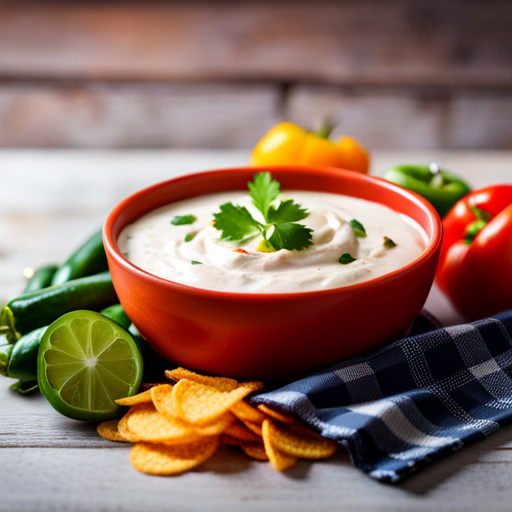Healthy Queso
Are you craving a cheesy indulgence without the guilt? Look no further than healthy queso!
This creamy and flavorful dip is made with nutritious ingredients that won’t compromise your waistline.
In this article, we’ll show you how to create a lighter version of this beloved classic. From alternative cheeses to gluten-free options, we’ve got you covered.
Get ready to enjoy a bowl of queso that not only satisfies your cravings but also keeps you on track with your health goals.
Types of Healthy Cheese for Queso
To make a healthier version of queso, you can use different types of cheese that are low in fat but still provide a creamy and flavorful taste.
When it comes to alternative cheese options for queso, there are several nutritious choices available.
One option is cottage cheese, which is a great source of protein and low in fat. It has a mild flavor that blends well with other ingredients.
Another alternative is reduced-fat cheddar cheese, which is lower in fat and calories compared to regular cheddar cheese. It still delivers a rich and tangy taste that pairs well with queso ingredients.
Additionally, you can try using part-skim mozzarella cheese, which is lower in fat and sodium. It melts easily and adds a gooey texture to your queso.
Lastly, Greek yogurt can also be used as a healthier cheese alternative. It’s low in fat and high in protein, providing a creamy and tangy flavor to your queso.
These alternative cheese options not only reduce the fat content of your queso but also offer nutritional benefits such as protein and calcium, making your queso a healthier choice.
The Best Alternative Ingredients for a Lighter Queso
For a lighter queso, consider incorporating some of the best alternative ingredients that can reduce the calorie content while still maintaining a delicious and creamy texture. Here are three options to consider:
-
Greek Yogurt: Greek yogurt is a fantastic substitute for traditional queso ingredients like cream or sour cream. It’s low in fat and calories while still providing a creamy and tangy flavor. Greek yogurt also adds a boost of protein and calcium, making it a healthier choice overall.
-
Nutritional Yeast: Nutritional yeast is a popular ingredient in vegan queso recipes. It has a cheesy flavor and a powdery texture that can mimic the taste and texture of traditional queso. Nutritional yeast is low in calories and packed with B vitamins, making it a nutritious addition to your lighter queso recipe.
-
Butternut Squash: Pureed butternut squash can be used as a base for a lighter queso. It adds a smooth and creamy texture while reducing the calorie content. Butternut squash is also rich in vitamins A and C, fiber, and antioxidants, making it a healthy alternative ingredient.
Incorporating these alternative ingredients into your lighter queso recipes can provide you with a flavorful and nutritious dip that you can enjoy guilt-free. So go ahead and experiment with these options to create a delicious and healthier queso experience.
Easy and Nutritious Queso Dip Recipes
If you’re looking for easy and nutritious queso dip recipes, try incorporating these alternative ingredients for a lighter and healthier option. Traditional queso dips often contain high amounts of dairy, which can be problematic for those who are lactose intolerant or following a dairy-free diet. Fortunately, there are several delicious and dairy-free queso recipes available that use alternative ingredients.
One popular alternative is cashews, which can be soaked and blended to create a creamy base for the queso. Nutritional yeast can also be added to give it a cheesy flavor. Another option is using vegetables like cauliflower or butternut squash, which can be roasted and pureed to create a smooth and flavorful dip. These alternatives not only provide a creamy texture but also offer added nutrients.
When it comes to presentation, there are many creative queso dip ideas to consider. You can serve the dip in a hollowed-out bread bowl, with colorful vegetable sticks or tortilla chips arranged around it. Another option is to use mini individual serving bowls and garnish each with fresh herbs or a sprinkle of paprika for an eye-catching touch.
Healthier Queso Options for Gluten-Free Diets
For those following a gluten-free diet, there are healthier options available for queso that can still provide a creamy and flavorful dip. Going gluten-free can have several benefits, such as improved digestion, increased energy levels, and reduced inflammation. Here are three delicious and gluten-free queso recipes to try:
-
Cauliflower Queso: Replace the traditional cheese with steamed cauliflower for a lighter and gluten-free alternative. Blend the cauliflower with nutritional yeast, garlic powder, cumin, and a touch of almond milk for a creamy and cheesy texture. Serve with gluten-free tortilla chips or fresh veggies for a satisfying snack.
-
Cashew Queso: Soak cashews overnight and blend them with roasted red peppers, nutritional yeast, garlic, and a splash of lime juice. This dairy-free and gluten-free queso is rich, creamy, and packed with flavor. It’s perfect for dipping nachos, drizzling over tacos, or even as a spread for sandwiches.
-
Sweet Potato Queso: Roast sweet potatoes until tender, then blend them with vegetable broth, nutritional yeast, smoked paprika, and a pinch of chili powder. This gluten-free queso has a sweet and smoky flavor that pairs well with corn chips or roasted vegetables.
Adding Vegetables to Your Queso for Extra Nutrition
To boost the nutritional value of your queso, incorporate a variety of vegetables into the recipe. Adding vegetables to your queso not only enhances its flavor and texture but also provides numerous health benefits. A vegetable loaded queso can be a delicious and nutritious addition to your meals.
One of the main benefits of adding veggies to queso is the increased intake of essential vitamins and minerals. Vegetables like bell peppers, onions, and tomatoes are rich in vitamins A and C, which are important for immune function and overall health. They also provide dietary fiber, which aids in digestion and helps maintain a healthy weight.
Additionally, vegetables add color and freshness to your queso, making it visually appealing and appetizing. The vibrant hues of red, green, and yellow in peppers and tomatoes not only make your queso more aesthetically pleasing but also indicate the presence of beneficial antioxidants. Antioxidants help protect your body against oxidative stress and reduce the risk of chronic diseases.
Furthermore, by adding vegetables to your queso, you can increase the volume of the dish without significantly increasing the calorie content. This can help you feel more satisfied and reduce the temptation to overeat.
Tips for Reducing Calories and Fat in Your Queso
To reduce the calories and fat content in your queso, try incorporating these tips into your recipe:
-
Portion control: One of the simplest ways to reduce the calorie and fat content in your queso is to watch your portion sizes. Instead of indulging in a large serving, try limiting yourself to a smaller portion. This will help you enjoy the flavors without going overboard on calories and fat.
-
Use alternative dairy options: Traditional queso recipes often call for high-fat ingredients like full-fat cheese and cream. However, you can reduce the calorie and fat content by using alternative dairy options. Consider using reduced-fat or low-fat cheese, Greek yogurt, or even plant-based options like almond milk or cashew cream. These alternatives can provide a creamy texture and delicious taste while cutting down on calories and fat.
-
Incorporate more vegetables: Adding vegetables to your queso not only boosts its nutritional value but also helps reduce the overall calorie and fat content. Consider adding diced tomatoes, onions, bell peppers, or even spinach to your recipe. These veggies add flavor, texture, and nutrients while keeping the overall calorie count in check.
Serving Suggestions for a Well-Rounded Queso Experience
To enhance your well-rounded queso experience, consider pairing it with an assortment of flavorful dippers. The right choice of queso accompaniments can complement the creamy, savory flavor of the queso and provide a variety of textures and tastes. When it comes to serving presentation, you can get creative with your dipper selection to make it visually appealing and enticing.
One option for queso dippers is tortilla chips. Opt for baked or whole grain versions to keep it healthier. These crispy chips add a satisfying crunch to each bite and are a classic choice for queso.
Another option is fresh vegetables like carrot sticks, celery, or bell pepper slices. They not only provide a refreshing contrast to the rich queso but also add some nutritional value.
If you’re looking for a heartier option, consider serving queso with warm, crusty bread or soft pretzels. These bread-based dippers can soak up the queso and offer a delectable combination of flavors.
Additionally, you can try pairing your queso with grilled shrimp or chicken skewers for a protein-packed twist.
Remember to serve the dippers alongside the queso in a visually appealing manner. Arrange them on a platter or in individual bowls to make it easy for everyone to enjoy.
With these serving suggestions, you can elevate your queso experience and create a well-rounded and satisfying snack or appetizer.
Frequently Asked Questions
Can I Make Queso Without Cheese?
Yes, you can make queso without cheese! There are vegan cheese substitutes available that can be used as a healthy alternative. Experiment with ingredients like nutritional yeast, cashews, or potatoes for a delicious and nutritious queso dip.
Can I Use Dairy-Free Alternatives in My Queso Dip?
You can definitely use dairy-free alternatives in your queso dip! There are plenty of healthy queso recipes that swap out traditional cheese for plant-based options, like cashews or nutritional yeast. Give it a try!
Are There Any Vegan Options for Queso?
Yes, there are vegan queso recipes available that use alternatives to dairy, such as cashews, nutritional yeast, and plant-based milk. These options provide a healthier, dairy-free alternative for your queso cravings.
How Can I Make Queso Without Using Processed Ingredients?
Looking for a healthier alternative to queso? Try making it without processed ingredients. Use real cheese, fresh vegetables, and spices for a flavorful and nutritious dip. Who knew healthy queso could be so delicious?
Can I Make Queso That Is Low in Sodium?
Yes, you can make queso that is low in sodium. There are plenty of healthy queso recipes available that use low sodium alternatives, such as reduced-sodium cheese and spices instead of salt.
Conclusion
In conclusion, by choosing healthier cheese options and incorporating alternative ingredients, you can enjoy a lighter and more nutritious queso dip.
Adding vegetables not only enhances the flavor but also boosts the nutritional value of your queso.
With some simple tips, you can reduce the calories and fat in your queso without sacrificing taste.
Consider these suggestions and serve your queso with a variety of accompaniments for a well-rounded and satisfying experience.






